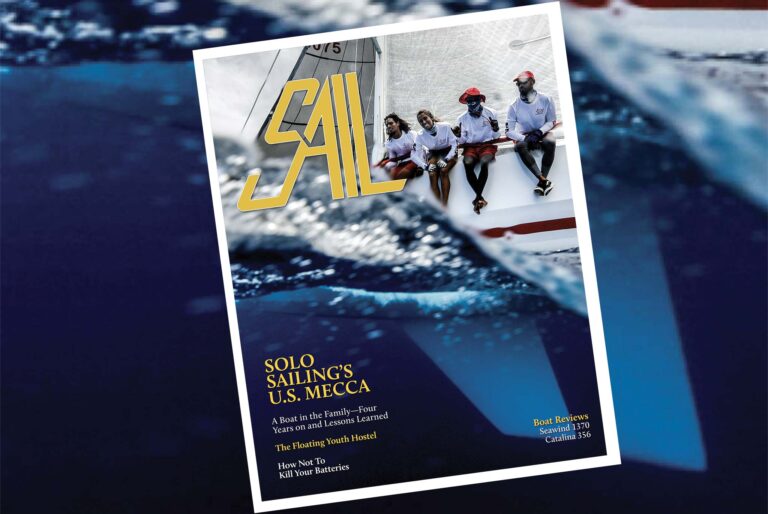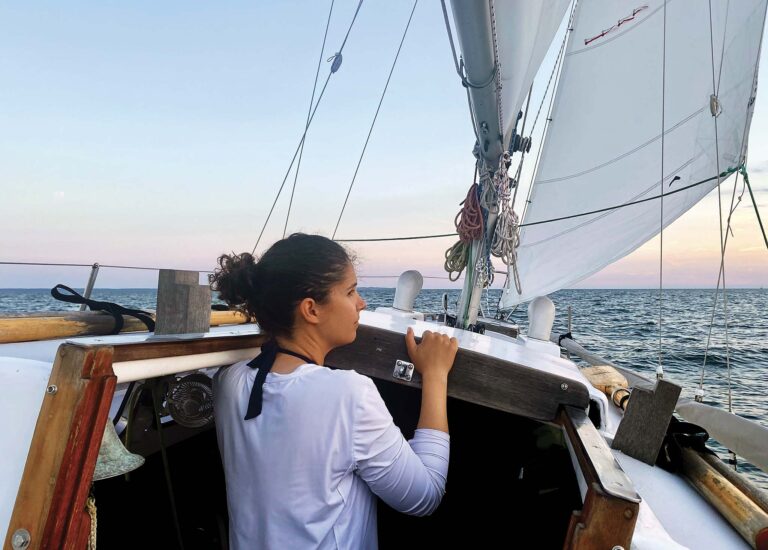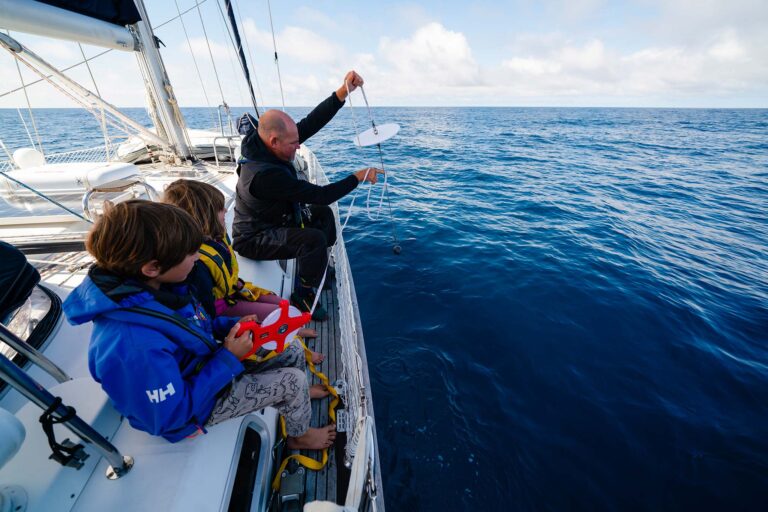
Few bodies of water have such a fearsome reputation—or have exerted as powerful an effect in shaping the course of history—as the Bay of Biscay. Enclosed by the Atlantic coast of France and northern coast of Spain, the bay measures less than 350 miles from headland to headland but is approximately 250 miles deep. At 86,000 square miles, it covers roughly two and a half times the area of Lake Superior.
Today, Biscay is associated with races like the Vendée Globe and the Mini Transat. Yet these events and the attendant innovative boatbuilding industry based on the Atlantic coast of France are just the latest chapters in fascinating maritime history.

Central to this history is the area’s rough weather. The region has long been feared by seafarers, and in the days of trading under sail, becoming “embayed” in Biscay could spell disaster for square-riggers, in particular. To this day it demands respect from commercial shipping—the past 45 years alone have seen no less than three large tankers founder off the port of A Coruña on the tip of Spain, spilling more than 230,000 tons of oil in the process. Thankfully, the resulting mess has been largely cleaned up, and the area’s marine ecosystems are recovering. Nonetheless, there’s good reason why the Spanish call this area la Costa de la Muerte—the Coast of Death.
Biscay’s weather and geography were also significant factors in the many sea battles fought there between British ships and those of France, Spain and Germany for over 450 years until the end of World War ll.

During the Napoleonic era, for example, from 1803 to 1815, the sea state in many of the battles that took place on the Bay of Biscay prevented French vessels from opening their lower gun ports, significantly restricting their firepower. Equally, the lee shore was an ever-present danger, with single incidents capable of inflicting hundreds of deaths. Many times during the British blockade of the port of Brest, the fleet was forced by the weather to retreat up to 40 miles out in the Atlantic to avoid being cast upon the rocks close to land.
Today, although Biscay is often thought of as an area for yachts in transit to simply get over with, there are also excellent cruising areas to be found there, particularly along the French coast between Brest and La Rochelle, and among the rias, or bays, of Galicia in northwestern Spain. With waters warmed by the Gulf Stream, the area is also a good deal more comfortable year-round than its latitude might suggest.
That said, the bay can also represent a substantial barrier for Northern European yachts heading south to sunnier climes. This is especially true out of season in winter, when the area is pummelled by low-pressure system after low-pressure system coming out of the west. These can produce dangerous waves on the edge of the European continental shelf, where depths rise from more than 13,000ft to less than 700ft over a distance of little more than 30 miles.
Many European sailors have scary stories of Biscay crossings, including more than a few whose yachts have been rolled upside down. Among the latter is British solo racer Alex Thomson, whose IMOCA 60 Hugo Boss was capsized by a rogue wave some 80 miles off A Coruña during the 2015 Transat Jacques Vabre race.
By contrast, during the summer months, there can be prolonged periods of high pressure with little wind. These conditions can also be found in the winter and offer the opportunity for an incident-free passage in any season. However, before setting out it’s important to watch for a weather pattern with low pressure to the south of a high-pressure system, as this can create very strong easterly winds, especially in the southwestern part of the bay.

French Atlantic Coast
The northwestern extremity of France has a well-deserved reputation as a potentially treacherous stretch of water, due largely to the headlands, off-lying islands and rock-strewn channels that form the Chanel du Four and Raz du Sein. These have tidal ranges of 20ft or more and tidal currents exceeding 5 knots. Further complicating things, less than 10 miles offshore lies the Ushant traffic separation scheme, with some of the world’s busiest shipping lanes.
At the same time, the Rade de Brest provides a sheltered sailing area of some 70 square miles, while Douarnenez bay immediately to the south offers an even larger, though less sheltered, playground. From there, a wonderful cruising ground opens up along the 200 miles between Douarnenez and La Rochelle. There’s an amazing mix of long sandy beaches, deeply indented bays, sheltered estuaries and iconic harbors, including Les Sables d’Olonne, host of the Vendée Globe and Global Ocean races.
Today this part of France is home to many of the best-known brands and most innovative companies in the sailing world, ranging from high-tech inflatable sailing dinghy manufacturer Tiwalea to Marsaudon Composites, a builder of large performance cruising catamarans, and Groupe Beneteau.
At the same time, there’s also a great deal of enthusiasm for traditional craft, with the region hosting a plethora of classic boat festivals, some featuring 1,000 vessels for more, like the Brest International Maritime Festival. These include everything from fishing luggers and rugged workboats originally built for cargo-carrying—or in many cases smuggling—to the most exquisite of yachts.
The off-lying islands are also part of the appeal of this region and add interest for anyone cruising here. Ile d’Ouessant (commonly referred to as “Ushant” by Brits and the starting and endpoint for the Jules Verne nonstop round-the-world sailing trophy) is remote and windswept, while Ile de Groix, Belle Ile, Ile d’Yeu and Ile de Ré offer a chance to relax at a slower pace, even with the latter being connected to La Rochelle via a giant bridge.
During the Second World War, German U-Boats were stationed at Brest, Lorient, St. Nazaire, La Rochelle and Bordeaux, where they were berthed and hauled ashore for maintenance in giant concrete hangers built to an astonishing specification, with 23ft-thick steel-reinforced roofs for protection against Allied air raids.
Today, in Lorient, one of the bigger hubs of the offshore racing scene, these same hangers have become home to Lorient La Base, a vibrant training and boatbuilding center. When I was last there, during the buildup to the 2018 Route de Rhum singlehanded transatlantic race, roughly one-third of the 123-strong fleet was preparing for the race here, including a trio of giant 98ft Ultime foiling trimarans, five IMOCA 60s and too many Class 40s to count.
In France, offshore racing is a national sport, with top sailors becoming household names similar to footballers and pro basketball players elsewhere. However, it’s also refreshingly egalitarian. And the docks here are open for anyone to see the top boats and skippers hard at work, whether it be Jérémie Beyou aboard the IMOCA 60 Charal or British sailor Sam Davies and her team aboard the boat, Initiatives-Cœur. La Base is also home to an excellent maritime museum dedicated to French sailing hero Eric Tabarly and (of course!) the history of submarines.
To the southeast of Lorient is the Gulf of Morbihan, a 44-square-mile natural harbor with numerous islands, stunning anchorages and yet more tides demanding of respect, especially the springs. The surrounding area is also home to a wide range of megalithic monuments and the stunning medieval city of Vannes.
Continuing south-southeast brings you to the city of La Rochelle, where the marine industry is truly king, with a municipal marina opened in 1972 that has since expanded to become the largest in Europe, with more than 5,000 berths. Although La Rochelle was the last city in France to be liberated at the end of World War ll, much of the old town survives or has been rebuilt. The plazas and streets to the north of the old docks, some of which date back to the 15th century, teeming with character and the most incredible variety of cafes and restaurants imaginable.
From La Rochelle the mouth of the Gironde, one of Europe’s largest rivers, is another 30 miles to the south. The bar here is dredged for commercial traffic, and there are marinas near the mouth of the estuary. Visiting yachts also often stop here en route to the Canal du Midi, a shortcut from the Gironde to the Mediterranean for vessels with a draft of 4ft 6in or less.
South of the Gironde the Biscay coast is lined by miles of massive sand dunes. It’s a stunningly beautiful but remote area with no safe havens, right up until you reach Basque country, a separate and distinct regional culture spanning the Franco-Spanish border.
Most Basque harbors, including the two best-known ports of Bilbao and Santander, are on the Spanish side. However, they are typically much less visited by cruising yachts simply because they represent such a big detour for boats heading south, with the overwhelming majority heading straight for Galicia.

Spain and Galicia
It’s impossible to avoid being awestruck by the ruggedly crenelated coast that results from the many Spanish rias highlighting this area. Ports range from bustling cities to quiet and astoundingly friendly backwaters, like Muros.
A Coruña is the most popular landfall for boats crossing the bay. It’s an attractive coastal city with an appealing old quarter near the marinas and a maritime heritage stretching back millennia. The headland outside the port, for example, is the site of the world’s oldest lighthouse still in use. It was constructed by Roman engineers in the second century CE, with the original 112ft-high tower extended to 181ft in 1788.
Impecunious cruisers used to hang out for extended periods at anchor in A Coruña while waiting for good weather to round infamous Cape Finisterre on their way south. However, the bulk of the old anchorage has since been replaced with a huge marina, the outer sections of which are sadly untenable due to the swell and surge.
As a whole Galicia is enormously less expensive to cruise than, say, the more popular parts of Europe and the Caribbean. However, there is a price to be paid for the area’s luscious greenery, in that is the fact that this is by far the wettest part of Spain, with rain on average every second day in winter. Fortunately, it’s warm here year-round, and the weather is a good deal drier between June and September.
For those with time, it’s worth venturing inland to Santiago del Compostela, an easy half-hour train ride south from A Coruña. This ancient city, with many fine buildings including a magnificent cathedral dating back to the 12th century, is the regional capital of Galicia.
It’s also the endpoint of the Camino de Santiago (Way of St. James), an iconic Catholic pilgrimage route travelled by as many as 300,000 people each year by bicycle or on foot. Many of these same travellers continue overland to the lighthouse on Cape Finisterre. It even recently became possible to include a voyage under sail to Galicia, en route to Santiago, as part of the pilgrimage.
Transiting the Bay of Biscay
For most people, crossing the Bay of Biscay will consist of a pleasant three-day passage in fine summer weather. In fact, I actually abandoned my first attempt, cruising a 1970s-era half tonner, not because of inclement weather, but because the delights of the French coast struck me as being far more appealing than the prospect of two days motoring across a ridge of high pressure.
Never forget, though, that the bay’s reputation for ferocity is richly deserved and should never be underestimated. In addition to heavy weather, fog can also be a problem in the spring and early summer, especially when approaching land at the end of the passage.

Pilot charts show gales recorded 13 percent of the time in winter, decreasing to one to two percent in between June and August. However, while long spells of settled weather are common at this time of year, there’s no guarantee of an absence of strong winds, and you should never let your guard down. In June 2019, Storm Miguel resulted in the deaths of three French lifeboat crew, no less, when their vessel overturned in winds of over 70 knots. I experienced this same storm myself 36 hours earlier while on passage from the UK to the Azores when it crossed our path as a rapidly intensifying secondary low. It was no laughing matter.
The fact that the distance from Ushant to A Coruña is approximately 340 miles makes for an easy sail given a free wind. Breaking the trip up into shorter hops is also an option. The distance from La Rochelle to Santander in Spain, for example, is only 200 miles, although this diversion will result in your having to sail almost twice the distance overall.
Those heading for destinations farther south, including the Mediterranean and Canary Islands, without stopping might want to consider staying farther offshore, outside the shipping lanes. This will also keep you clear of the headlands and confused seas off Galicia.
Unfortunately, boats travelling north from Portugal or the Mediterranean have to contend with the northeasterly trades. With that in mind, those with plenty of time often choose to avoid Biscay Bay altogether and follow a route well offshore toward the Azores. Veteran delivery skippers, however, invariably opt for the shortest route, making best use of the lighter airs typically found overnight and in the early morning to make their way north as quickly as they can under engine.
January 2021









